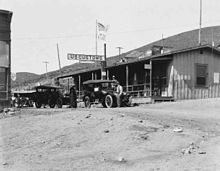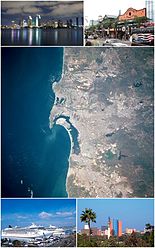
A border checkpoint is a location on an international border where travelers or goods are inspected and allowed passage through. Authorization often is required to enter a country through its borders. Access-controlled borders often have a limited number of checkpoints where they can be crossed without legal sanctions. Arrangements or treaties may be formed to allow or mandate less restrained crossings. Land border checkpoints can be contrasted with the customs and immigration facilities at seaports, international airports, and other ports of entry.
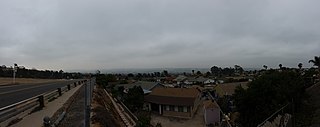
San Ysidro is a district of the City of San Diego, immediately north of the Mexico–United States border. It neighbors Otay Mesa West to the north, Otay Mesa to the east, and Nestor and the Tijuana River Valley to the west; together these communities form South San Diego, a practical exclave of the City of San Diego. Major thoroughfares include Beyer Boulevard and San Ysidro Boulevard.
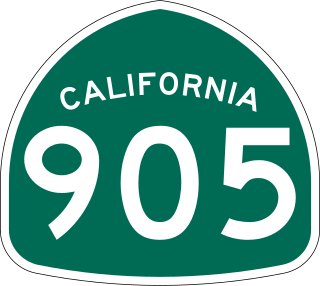
State Route 905 (SR 905), also known as the Otay Mesa Freeway, is an 8.964-mile-long (14.426 km) state highway in San Diego, in the southwestern part of the U.S. state of California. It connects I-5 and I-805 in San Ysidro to the Mexican border at Otay Mesa. The entire highway from I-5 to the international border is a freeway with a few exits that continues east from the I-805 interchange before turning southeast and reaching the border.

State Route 11 (SR 11) is a state highway in the U.S. state of California. The first phase of the highway opened in 2016, connecting SR 125 and SR 905 with Enrico Fermi Drive in the Otay Mesa area of San Diego. It is planned to be extended from Enrico Fermi Drive to the proposed U.S.–Mexico border crossing at Otay Mesa East. There are also plans for an interchange at Siempre Viva Road and to convert the highway to a toll road once the entire route is completed. Planning for the road began in the 1990s, and construction started in 2013.
Otay Mesa is a community in the southern section of the city of San Diego, just north of the U.S.–Mexico border.
The Progreso–Nuevo Progreso International Bridge, officially the Weslaco–Progreso International Bridge and also known as the B&P Bridge, is an international bridge over the Rio Grande on the U.S.–Mexico border, connecting the cities of Progreso, Texas and Nuevo Progreso, Río Bravo, Tamaulipas. It has been in operation since 1952.
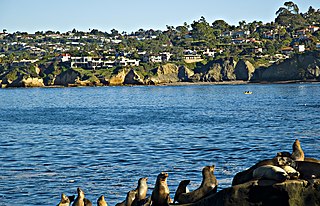
San Diego–Tijuana is an international transborder agglomeration, straddling the border of the adjacent North American coastal cities of San Diego, California, United States, and Tijuana, Baja California, Mexico. The 2020 population of the region was 5,456,577, making it the largest bi-national conurbation shared between the United States and Mexico, and the second-largest shared between the US and another country. The conurbation consists of the San Diego metropolitan area, in the United States and the municipalities of Tijuana, Rosarito Beach (126,980), and Tecate (108,440) in Mexico. It is the third most populous region in the California–Baja California region, smaller only than the metropolitan areas of Greater Los Angeles and the San Francisco Bay Area.

The Secure Electronic Network for Travelers Rapid Inspection (SENTRI) provides expedited U.S. Customs and Border Protection (CBP) processing, at the U.S.-Mexico border, of pre-approved travelers considered low-risk. Voluntarily applicants must undergo a thorough background check against criminal, customs, immigration, law enforcement, and terrorist databases; a 10-fingerprint law enforcement check; and a personal interview with a CBP Officer. The total enrollment fee is $122.50, and SENTRI status is valid for 5 years.
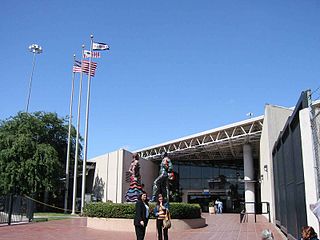
The Otay Mesa Port of Entry is one of three ports of entry (POE) in the San Diego–Tijuana metropolitan region, in the U.S. state of California, connecting Otay Mesa in the City of San Diego with the Otay Centenario borough of Tijuana. The facility was opened in 1983, and was constructed primarily to divert growing commercial truck traffic from the busy San Ysidro Port of Entry, located 5.2 miles (8.4 km) west. Since then, significant passenger vehicle and pedestrian traffic has grown as development in the area around the crossing has grown. Commercial importations through Otay Mesa accounts for billions of dollars' worth of freight.

The Tecate Port of Entry is one three ports of entry in the San Diego–Tijuana metropolitan region. The land port is located between Tecate, California in San Diego County's Mountain Empire and Tecate Municipality in Baja California. It connects California State Route 188 with Paseo Lázaro Cárdenas, a spur of Mexico Federal Highway 2, as well as Federal Highway 3 to the south. It is a minor port in comparison to the larger San Ysidro Port of Entry and Otay Mesa Port of Entry. This is attributed in part to the fact that reaching the crossing on the US side requires driving on narrow, winding mountain roads.

The San Luis Port of Entry has been a busy US port of entry since the early 1900s. It connects San Luis, Arizona, to San Luis Río Colorado, Sonora. It connects to U.S. Route 95 on the north and Mexican Federal Highway 2 as well as Sonora State Highway 40 on the south.

The Nogales Port of Entry evolved over time, rather than being planned. When an international fence divided Nogales in the early 20th century, vehicles were inspected at a gate at Grand Avenue, trains were inspected just east of there, and pedestrians were inspected further to the east at Morley Avenue. A small tile-roofed inspection station was completed in 1931 and was expanded in 1949. Substantial renovations were performed in 2011.

The El Paso Paso del Norte (PDN) Port of Entry is a crossing of the United States–Mexico border, connecting the U.S. city of El Paso, Texas with the Mexican city of Ciudad Juárez, Chihuahua. It is among the busiest border crossings between the two countries: more than 10 million people enter the U.S. from Mexico each year at this location. The PDN Port of Entry is located at the Paso del Norte International Bridge, and is limited to northbound non-commercial traffic, although pedestrians may also cross the bridge in the southbound direction.

The United States Custom House in San Ysidro, San Diego, California, is a 1933 Spanish Revival building located 50 feet (15 m) north of the Mexico–United States border at the San Ysidro Port of Entry. It is listed on the National Register of Historic Places with the full historic name U.S. Inspection Station/U.S. Custom House and common name U.S. Custom House.

Las Americas Premium Outlets is a 560,000 square feet (52,000 m2) outlet mall in San Ysidro, San Diego, California located directly on the Mexico–United States border just west of the San Ysidro Port of Entry at the new PedWest crossing from Tijuana to Virginia Avenue on the U.S. side.

The El Chaparral port of entry or border crossing is as of 2012 the main vehicle crossing point from San Diego into Tijuana, Mexico, replacing the former entry point known as Puerta México which stood immediately east of El Chaparral. It is part of the San Ysidro Port of Entry. It is roughly in the same location as the former Virginia Avenue crossing, where trucks entering the US from Mexico prior to 1983, was located. The opening of El Chaparral roughly tripled the number of traffic lanes to 22, reducing wait times for vehicles entering Mexico.
The Otay Mesa East Port of Entry is a planned border crossing between San Diego and Tijuana, approximately 2 miles east of the existing Otay Mesa Port of Entry. The crossing will connect the Otay Centenario borough of Tijuana with East Otay Mesa in unincorporated San Diego County, an as-yet undeveloped area slotted for future development including a business park. Although the crossing will allow cars and pedestrians, it is mainly designed for trucks and commercial vehicles.
East Otay Mesa is an as-yet undeveloped area in the South Bay region of unincorporated San Diego County, southern California.

Cross Border Xpress (CBX), historically also called the Tijuana Cross-border Terminal and the Puerta de las Californias, is an airport terminal located in the Otay Mesa area of southern San Diego, California, United States, with an access bridge connecting it to the Tijuana International Airport in Tijuana, Baja California, Mexico. It opened on December 9, 2015. It makes Tijuana Airport a geographically binational airport. Unlike the binational airports serving the Swiss cities of Basel and Geneva, the CBX terminal is physically located in the United States but serves an airport whose main terminal and runways are in Mexico. A pedestrian bridge spans the United States–Mexico border and Via de la Juventud Oriente in Tijuana, connecting passenger terminals between the two countries. It was the creation of Ralph Nieders, who introduced the concept and infrastructure design in Mexico City in 1989 and San Diego in 1990. The structural scheme allows passengers originating in, and destined to the United States direct access to the Tijuana airport and equally gives Mexican and international carriers operating from the Tijuana airport direct access to the U.S. passenger market.

Plaza Viva Tijuana is an open-air shopping center in the Empleados Federales neighborhood of Tijuana, located immediately across Frontera Street from what was, until 2012, the entrance to Mexico for all pedestrians crossing from the U.S. side of the San Ysidro of the border. It houses numerous pharmacies targeted at U.S. customers, handicraft and souvenir shops, restaurants, and one of Tijuana's largest gay nightclubs.






